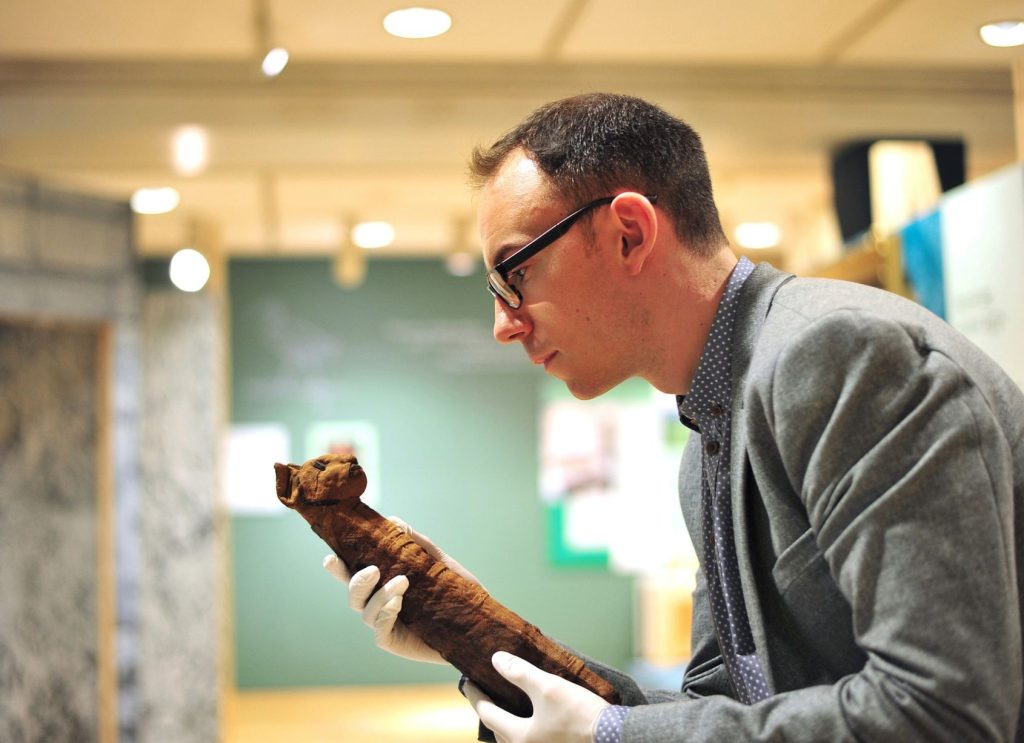Gifts for the Gods
The relationship between cats and deities was something explored in an exhibition by Campbell and colleagues a decade ago called Gifts for the Gods: Animal Mummies Revealed.
He says, “The exhibition explored the idea that almost every known mummified animal was sacrificed and given as a gift, much like how other religions may use the lighting of candles to ensure prayers reach the deity’s attention.”
Over time, Bastet came to be closely associated with qualities of grace, domesticity and protective guardianship, while Sekhmet embodied a fiercer, more destructive power. Rather than suggesting a straightforward evolution from one to the other, this reflects the way ancient Egyptian religion could hold multiple, sometimes contrasting aspects within its pantheon. Bastet and Sekhmet coexisted comfortably, illustrating how Egyptian beliefs embraced both the gentle and the ferocious, weaving animals into their spiritual and everyday lives in ways that were richly layered and often quite unlike the dogmatic structures of many modern faiths.
One of the challenges we face is that much of our understanding is filtered through the lens of classical Greek and Roman accounts but, more importantly, we often project our own modern perspectives onto ancient Egyptians. In doing so, we risk interpreting their beliefs and practices through contemporary values, rather than appreciating them on their own terms.
“Ethnography is notorious for misunderstandings,” says Campbell. “For example, Herodotus recounts a tale that if the cat in the household dies, that is not to say a pet cat, but simply a cat residing in the home, then the family would shave off their eyebrows.”
By modern standards, and even by the assumptions of the Greeks and Romans who first retold these stories, this has long been taken to mean that Egyptians were so devoted to their cats that they openly grieved them as kin. In truth, the act likely held deeper ritual or symbolic significance, not simply personal sorrow.
The narrative deepens when we consider the widespread practice of cat mummification in ancient Egypt. These were not simply embalmed household pets but often intentional votive offerings, numbering in the hundreds of thousands, as gifts made to Bastet and her divine sisters by devotees seeking blessings or healing. Scholarly research and scientific analyses of cat mummies have revealed that many cats were ritually sacrificed and embalmed, a practice reflecting profound religious significance.
Campbell reflects on this complex tradition, “The killing of these cats was ritualised, a sacrificial act to honour the gods. It was less about the individual animal and more about the spiritual exchange it facilitated. This challenges modern sensibilities, but it is crucial to understand these practices within their cultural and religious context.”
Between devotion and devastation
This duality, between reverence and sacrifice, speaks to a broader ancient Egyptian worldview in which the boundaries between life, death and the divine were permeable and interdependent. The cat’s role was multifaceted: protector, symbol and sacred offering. Campbell emphasises that to interpret these ancient practices by contemporary standards of pet-keeping risks flattening the rich layers of meaning behind them.
Our collection offers visitors an immersive encounter with this complexity. Among the highlights are delicately crafted cat amulets worn for protection, funerary statues embodying divine guardianship and intricately wrapped cat mummies that stand as silent witnesses to millennia-old rites.
Reframing our understanding
In a time when cats dominate social media and inspire affectionate memes, Campbell’s insights prompt a profound reflection on how we project modern values onto ancient cultures. He invites readers to engage with the past on its own terms, appreciating the distinct, sometimes uncomfortable realities that shaped ancient Egyptian life and belief.
Campbell concludes that we must try to move past the sentimental idea of cats merely as pets and appreciate their more profound cultural significance in the worldview of ancient Egypt. In doing so, we not only gain a fuller picture of ancient Egypt’s richness but also deepen our insight into humanity’s long-standing connections with animals.
Find the incredible cat-related artefacts we care for and discover the layers of meaning embedded in each piece from the sacred to the sacrificial and the protective to the symbolic.
Join us in unravelling the true story of cats in ancient Egypt, a story that transcends pet tales to touch on faith, ritual and the enduring human desire to connect with the divine.
Dr. Campbell Price
Campbell studied Egyptology at the University of Liverpool and has been Curator of Egypt and Sudan at Manchester Museum since 2011. He has lectured internationally, and regularly comments on Egyptological subjects for TV and audio. His latest book, ‘Brief Histories: Ancient Egypt’, is out now.
Key artefacts and objects:
Cat coffin
Mummified cat
Sekhmet statue fragment
